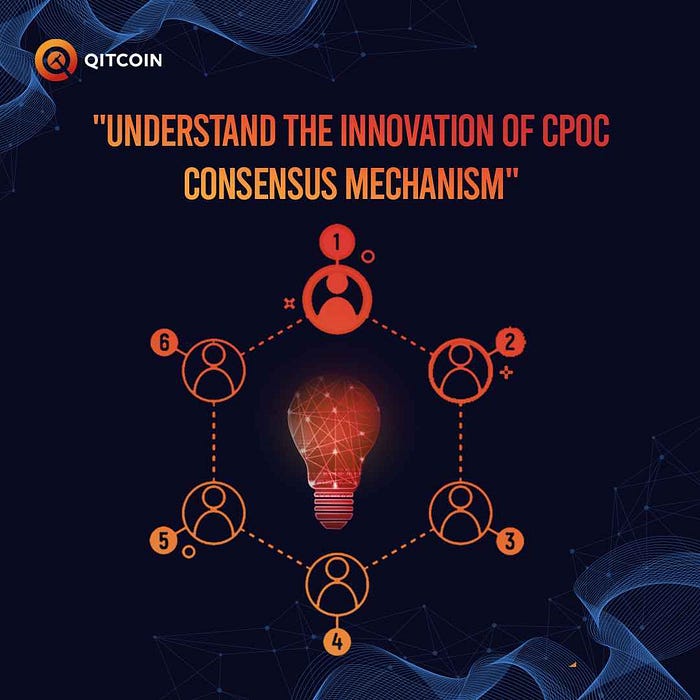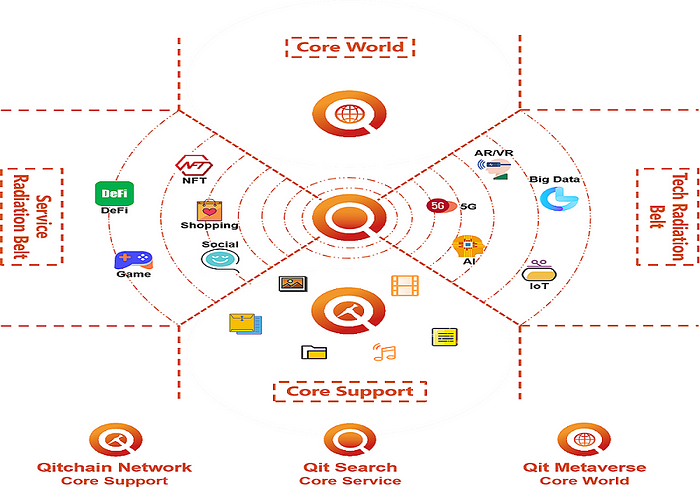
Deep Interpretation With Qitchain CEO: An Interview
Recently, CEO Qitchain Network Shoaib Hayat, has an exclusive interview with Golden Finance. He critically analyzed QitChain prospects development and the in-depth implementation of distributed search technology. Emerging technologies such as artificial intelligence, the Internet of Things, cloud computing, and 5G have made people’s lives more convenient, and the pace of information circulation in society has increased, thanks to the rapid growth of Internet technology. Huge data resources have sparked a data revolution in a variety of industries, the value of data has become increasingly apparent, and data security awareness is progressively expanding. Distributed technology has received high aspirations from many sectors of life in the face of centralized storage solutions with regular issues, and distributed storage has become one of the hottest tracks in contemporary Block chain application.
First interviewer asked to introduce yourself and core team members.
In the interview CEO of Qitchain informed audience about his contribution to cryptography technology in some open-source projects. The idea of Qitchain project arouse at that time. Later, he found six more core members to work on the same idea including Sam Catchpole (CTO), Plasiap (Technical Consultant), Daniel Alejandro Lugo (Graphics Designer), Daniel Ruvens (Business Consultant) and Antoine Kuseyan (Business Director). Some of the founding teams from IPFS, and others from the original Google team, have expertise in artificial intelligence (AI), blockchain, and big data. They all possessed a very strong obsession and enthusiasm for the development and application of these products.
In 2017, the core team was established and named as “Tree Team”, mainly because of the four technical breakthroughs and innovations about the “Tree” in the research and development process of the QITCOIN project:
1. A write-efficient ADS AC tree is designed. Based on the AC trees, the AC * trees were designed to optimize the time-window-based queries. Verifiable connection query is implemented based on AC tree and AC * tree, which greatly improves the query performance of verifiable range and connection queries.
2. We propose a cryptographic accumulator-based ADS GCA2 tree to support blockchain-oriented verifiable multidimensional cluster queries.
3. QitChain first uses the query compiler to parse the query and generate an abstract syntax tree, making two query types supported in QitChain: full-node oriented and light-node-oriented queries.
4. It uses the MPT tree to develop the QitChain.
It supports the verifiable query of state data by light nodes. The root node hash value of the MPT tree stored in each block header corresponds to a snapshot of a state database, which can support the rapid restart recovery of the nodes. Due to the high energy consumption of POW at the time, the underlying Qitchain primarily innovated the consensus mechanism based on bitcoin, testing nearly 1,000 times on the participation model and consulting a well-known Wall Street fund manager, we eventually decided to upgrade the consensus mechanism again, which is the current CPOC consensus mechanism; this innovation has also received funding from closest partners. The “Tree Team” formally launched the “Search Laboratory” in November 2020, and has since created advisory teams in North America, Europe, Asia Pacific, and other locations, as well as approximately 20 test nodes. A special gratitude goes out to the Asia Pacific advisory team for their outstanding performance and efforts. In order to better meet the aim of “effective data and secure network,” the team will modify the underlying protocol’s scalability and implement smart contracts at the initial consensus stage.

They were asked about the significance of the upgradation of search technology for WEB3.0 and future development and the reason behind choosing distributed technology specifically in Block chain.
In response to this they elaborated that Imagine that a company owns a server farm comprised of 10,000 computers use to maintain a database holding all of its client’s account information. This company owns a warehouse building that contains all of these computers under one roof and has full control of each of these computers and all the information contained within them. This, however, provides a single point of failure. What happens if the electricity at that location goes out? Or its internet connection is severed? What if it burns to the ground? What if a bad actor erases everything with a single keystroke? In any case, the data is lost or corrupted. So that’s why we chose the distributed technology to split and copy the data on every single node at different location to sustain the availability of reliable data. With the advent of Web3.0, privacy, data, rights, censorship, and identity have gradually become hot topics. The meaning of Web3.0 is to decentralize the Web. The distributed storage protocol will become a supplement or alternative to HTTP. It makes up for the pain points in the existing blockchain system, and solves shortcomings in file storage with non-tamper able and time stamp proof features.
They have discussed about the original intention of QitChain and its future vision.
The original intention of Qitchain is to build a search engine which allowed people to take ownership of their resources and freedom, and to empower data owners through decentralization. It also envisaged the monetary and other benefits accrued from that data shall be directed to the owners, without the middlemen. Summing it up, this means: “my data, my value”. When compared to conventional search technologies, we may not know that when we explore the Internet, whether through search engines, social media, or giant retailers, a significant amount of our personal information is monitored and logged in some way. This data is then used in a variety of advertising efforts. These companies pay a lot of money to be a part of the billion-dollar online consumer sector in the hopes of getting a piece of it. These campaigns are manifested in the intrusive pop-up adverts and generally irrelevant sponsored advertisements that pollute our internet experience on a regularly. The so-called decentralized distributed search engine means that there is no central control. They are scattered on different nodes of the network. With an open search engine, no search engine can own your data. They even do not have permission to access your search information.
Then he put some light on what problems will the development of QitChain solve for the blockchain.
As Block chain applications grow in scope and volume, the demand for querying these systems increases as well. Although the full node stores all the block data, the current Block chain system has limited support for full node queries, and it still has the following shortcomings in data query processing:
1. Data semantics are not rich enough.
2. There is insufficient data manipulation.
3. On-chain/off-chain data integration is complex.
Qitchain introduced relational semantics in the Block chain ecosystem, complex queries are enabled, composed of basic relational operators such as selection, projection, and connection. As a result, query processing capacity improves even though only one piece of data is stored. In addition, additional costs are avoided. ADS construction and storage overhead: Qitchain proposed a cryptographic accumulator-based ADS GCA2 tree to support verifiable multi-dimensional aggregation queries for Block chain.
Next the interviewer asked about that how does QitChain ensure the authenticity and security of data under the premise of decentralization?
In reply to that CEO said that QITCHAIN made use of edge computing technology to encrypt and store data on the individual web end as soon as it is created, ensuring its validity, dispersion, security, and integrity.

He was asked about QitChain’s unique CPOC consensus mechanism, difference between Filecoin’s model? Will users under the CPOC mechanism also face severe offline penalties and device thresholds.
CEO explains QitChain’s CPOC (Conditioned-Proof of Capacity) consensus algorithm, which is a conditional proof of capacity. Following the PoC consensus, the POS consensus mechanism was added, requiring miners to use the QTC as a mortgage, while simultaneously participating in pos incentives. POC algorithm is friendly to the light node, which is conducive to the formation of a safe network at the same time, the storage provider needs to provide the QTC of the coefficient of 5 times (360 days of pledge) or 10 times (540 days) of storage amount (the coefficient will be halved with the total amount), forming a huge demand for QTC spot. CPOC consensus mechanism: the POC revenue of storage providers can participate in the top 10 nodes of POS competition, To get 20% of the total network output as a reward, The premise of participation will be QTC spot for 360 days and 540 days of lock warehouse, Such consensus mechanisms, Effective intervention in the currency of the world’s big storage providers, greatly reduced the spot and selling pressure in the market, conducive to the formation of global consensus, More favorable and the technology of the update iteration and ecological formation, Make QTC available for more Block chain projects, in compliance with LTC, NFT, Metaverse etc. offers free, highly active, secure storage and search services
The CPoC consensus mechanism has the following characteristics:
1) Economic mode attack and prevention: Zhonghai Mining economic mode makes miners a community of ecological interests, using Yuan assets as new production materials, rather than the original electricity consumption resources, to expand the ecological continuously.
2) Low maintenance cost: the blockchain system based on the POW consensus needs to consume a lot of hardware resources and power resources to maintain its security. The miners cannot establish common interests and mutual recognition, and the resources consumed cannot exist in their value system. The values of this section have been extracted from the POW system. Without value drive, key technologies are difficult to update, obtain long-term effective development and iterations, and can easily lead to bifurcations in subsequent work.
3) Hardware monopoly: the CPoC consensus mechanism is mainly based on the hard drive. Hard disk systems have slow iteration, low threshold, and ship regularly. There is no need to worry about not buying a hard drive. Everyone can participate in mining activities. Under standard commercial supply chains, suppliers are few direct competitors to users; however, in POW of war systems, hardware manufacturers are direct competitors for miners, and their suppliers can use miners directly as an exchange tool.
4) Monopoly of power resources: power monopoly makes the endogenous ecology of prisoners of war impossible. Mining costs are more important to miners than their enthusiasm for environmental development. Under the CPoC system, the hard drive consumes minimal power, and the miners’ earnings will be more transparent. Linear hedging rates based on civilian computer technology ensure that miners can gain value with relative safety and capital.
The difference from the FILECOIN model is that the FIL uses a spatial proof very similar to the POW. The QTC will not have forfeiture and punishment mechanisms.

The next question was to introduce QitChain’s ecological construction plan in detail? What roles are included in the entire ecosystem? What application scenarios does it have.
In reply he said that the ecological system construction plan of Qitchain Network can be summarized with “three cores and two radiation belts,” including core support Qitchain Network, core service Qit Search, core world Qit Metaverse, service radiation belt, and technology radiation belt.
Three Cores are also discussed which are Qitchain Network, Qit Search and Qit Metaverse.
1) Qitchain Network: Qitchain Network provides the underlying blockchain support. In the future, we will upgrade the CPoC consensus mechanism to enable the district. All kinds of documents, audio, video, code and other files can be safely stored on the chain. This is also the core and bottom support for realizing the value of the entire ecosystem.
2) Qit Search: Qit Search is a decentralized search engine. The construction of the entire search engine will follow the Web3.0 system idea. It will provide users with SaaS (Search as a Service) capabilities of decentralized services. Each service does not need to be downloaded, and each user has their own data rights.
3) Qit Metaverse: Based on the support of the other two cores and two radiation belts in the ecosystem, we will launch Metaverse products in the future. This is a truly completely decentralized virtual world and a searchable virtual world. In this world, users can experience the convenience of the virtual meeting brought to life, and they can also meet and negotiate with customers in this world or play a game for a while to relax.
Two Radiation Belts are also used named as service radiation belt and technology radiation belt are also explained. QitChain’s entire economic concept is based on pledges. QTC is set up as a search engine data storage and search, download, and other ecosystems, such as a mall, knowledge payment, training, and so on, in order to secure QTC’s following liquidity.
Next, he defines that how can ordinary people participate in the construction of QitChain network? How many nodes are on the network now?
Participants in the Qitchain network can be divided into six roles: mining pools, miners, coin holders, wallets, exchanges, and hardware service providers. The whole network is currently between 200p and 300p.

Then he was asked to introduce the economic model of QTC, how to support the entire ecology of QitChain from the economic incentive part.
In reply CEO briefly explains the economic model of QTC and said that by building a long-term incentive economic model based on the Proof of Capacity (PoC) consensus method, QTC promotes the healthy development of the entire coin. Conversely, it strengthens PoC, resulting in a consensus approach known as Conditioned Proof of Capacity (CPoC). Equity incentives have been raised in accordance with the Point of Stake (PoS) model, resulting in enhanced community consensus. Total Supply, 105 million tokens (105,000,000). The total Block Time is 3 minutes and initial Block Size, 75QTC / Block, 2MB block size. The Halving Cycle, the first halving time is 420,000 block heights, and in the future, the height of 700,000 blocks will be halved every time. Then, the Initial Transactions Per Second (TPS), 70 TPS is evident. The Conditional Proof of Capacity (CPOC), A pledge period of 360 days requires 10QTC/T, and a pledge period of 540 days requires 5QTC/T.
Economic incentive, the application and effect analysis of POC algorithm in QTC:
1. Friendly to the light node, which is conducive to the formation of a safe network at the same time, the storage provider needs to provide the QTC of the coefficient of 5 times (360 days of pledge) or 10 times (540 days) of storage amount (the coefficient will be halved with the total amount), forming a huge demand for QTC spot
2. CPOC consensus mechanism: the POC revenue of storage providers can participate in the top 10 nodes of POS competition, To get 20% of the total network output as a reward, The premise of participation will be QTC spot for 360 days and 540 days of lock warehouse, Such consensus mechanisms, Effective intervention in the currency of the world’s big storage providers, greatly reduced the spot and selling pressure in the market, conducive to the formation of global consensus, More favorable and the technology of the update iteration and ecological formation, Make QTC available for more blockchain projects, in compliance with LTC, NFT, Metaverse etc. offers free, highly active, Secure storage and search services.
3. The project party holds less coins, and most of them are distributed to storage merchants, requiring a large number of ordinary people to enter the market. Due to the consensus layer of pos incentive, will form the QTC scarcity in circulation, and the price is high, in order to facilitate the formation of the security network, the project will properly release QTC adjust the market price to reduce the entry threshold of light nodes, so greatly reduce the project may pressure, further optimize the security of the network, at the same time promote the establishment of global nodes, prevent ecological construction.
Then he describes the application scenarios of QTC in the entire ecology? And how will QitChain empower the value of QTC.
The pledge demand halving is synchronized with the block halving period. QitChain expands its scalability from the ground up and increases the smart contract layer, eventually building a broad ecosystem with QTC as the metadata.
At the end he describes the current progress of the QitChain project, achievements and next development plan and layout
Currently, in the first stage the whole network computing power is 200P-300P, the global consensus is being formed. The next development plan and layout:
- Improve Turing’s complete virtual machine so that smart contracts can achieve more functions;
- Upgrade the CPoC consensus mechanism to CPoC+, and establish a complete decentralized storage standard;
- Establish a developer platform to allow more people to participate in ecological construction;
- Complete a preliminary decentralized search engine to provide content services and information retrieval;
- The service radiation belt forms a relatively complete system;
- Started the tentative integration of technology radiation belt, Qitchain Network and Qit Search.
